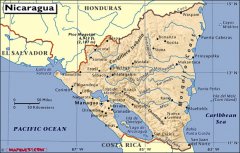Nicaraguan coffee plantation, Nicaraguan coffee growing environment, Nicaraguan coffee.
Nicaragua is located in the middle of Central America. It is the largest country in Central America. It borders Honduras in the north, Costa Rica in the south, the Caribbean Sea in the east and the Pacific Ocean in the west. Its eastern coastal plain, high temperature and rainy tropical marine climate, multi-jungle swamp; western coastal lowlands, there are more active volcanoes. The central north is highland, with an annual average temperature of 18℃ and annual precipitation of 1500~2500 mm.
Suitable climate provides a good growing environment for coffee cultivation. The mineral-rich volcanic ash soil provides abundant nutrients for the cultivation of coffee trees. High-quality Nicaragua coffee is also grown in the northern and central highlands of the country. The best coffee is produced in Matagalpa, where coffee is highly respected by coffee lovers all over the world and is gradually being valued by the boutique world. Abundant precipitation, suitable temperature, high altitude, fertile soil and unique planting ecology are the prerequisites for producing high-quality coffee in Nicaragua.
Nicaragua is an economically backward agricultural country and one of the poorest countries in Central America. The unemployment rate is very high and the people live in poverty. Coffee is the pillar industry of Nicaragua, producing nearly 100,000 tons of coffee beans every year. Because of the poor economic base, the coffee industry is still relatively backward, and coffee farmers are also in a relatively poor state.
Although Nicaragua is a large country in Central America, it is not a big producer of coffee in the world. Compared with its neighbor Costa Rica, its production and reputation are much weaker. However, Nicaragua coffee of high quality ranks among the top coffee beans in the world and enjoys a reputation.
Traditional Nicaragua coffee farmers are accustomed to washing coffee fruits for subsequent processing. Coffee farmers became more accustomed to using washing to ensure that the flavor of green coffee beans was more stable and clean. It was not until about 2009 that the traditional concept of coffee farmers changed and more areas began to try processing methods such as full sun and honey treatment.
The Matagalpa region mentioned earlier is the coffee region that produces the best coffee in Nicaragua, and here is a heavyweight coffee estate worth introducing-El Limoncillo. The estate is located in the plateau area between 950 and 1300 meters above sea level in Matagalpa. The coffee trees planted are surrounded by tall coniferous forests, providing shade for the growth of coffee trees. This allows the coffee tree to both get sunlight and protect the plant from the sun.
In order to ensure the quality of coffee, manual picking method will be used in the picking process of coffee fruit, and the fully ripe fruit will be picked one by one. It usually takes three times to complete the picking. Although the manual picking method is high in labor cost and low in picking efficiency, it can greatly protect the plants from damage during the picking process, and the ripe fruits will have better sweetness. The producers 'efforts were not in vain. Lemon Tree Coffee won the second place in Nicaragua's COE National Competition in 2008. This bean has a beautiful appearance, delicate and rich flavor after washing, with fruit and vanilla, cream aroma, since the first battle to become famous to get more attention.
Lemon Tree Manor also processes coffee in a honeyed way. After the coffee fruit is picked, the coffee with the exocarp removed is placed on an African shed to dry. Compared with the traditional way of placing coffee directly on the ground for drying, the use of African shed drying coffee reduces pollution in the drying process, avoids more miscellaneous smells, and finally improves the quality of coffee. After honey treatment, coffee beans have more attractive tropical fruit flavor.
The coffee beans with exquisite flavor presented in front of us, whether from picking, planting, processing methods, etc., or later packaging and transportation links, have poured into the producers 'good intentions. In the process of making coffee into cups, we should also treat them carefully.
Source: Know
Important Notice :
前街咖啡 FrontStreet Coffee has moved to new addredd:
FrontStreet Coffee Address: 315,Donghua East Road,GuangZhou
Tel:020 38364473
- Prev

The species of Nagagua introduce the flavor characteristics of Nicaragua and the growing areas of Nicaragua.
Nicaragua: Nicaraguan coffee flavor characteristics: moderate acidity, fragrant and delicious. Nicaraguan coffee of high quality is in the forefront of coffee beans in the world and enjoys a good reputation. Its particles are moderate in size, mild in taste and very aromatic and mellow. Nicaragua is located in central Central America, bordered by the Pacific Ocean to the west and the Caribbean Sea to the east. The highland in the north and the coastal plain in the east, belonging to Central America.
- Next

The flavor of Peruvian coffee, the main producing area of Peruvian coffee.
As a rising star in the coffee industry, Peruvian coffee is gradually opening up its popularity and entering the international market. Peruvian coffee has always been used as one of the stable and mellow mixed beans of comprehensive coffee. Peruvian coffee has a mellow taste and the right acidity, and this lukewarm coffee attitude has made more and more people like it. Peru is located in western South America, with a coastline of 2254 kilometers. Andes
Related
- Detailed explanation of Jadeite planting Land in Panamanian Jadeite Manor introduction to the grading system of Jadeite competitive bidding, Red bid, Green bid and Rose Summer
- Story of Coffee planting in Brenka region of Costa Rica Stonehenge Manor anaerobic heavy honey treatment of flavor mouth
- What's on the barrel of Blue Mountain Coffee beans?
- Can American coffee also pull flowers? How to use hot American style to pull out a good-looking pattern?
- Can you make a cold extract with coffee beans? What is the right proportion for cold-extracted coffee formula?
- Indonesian PWN Gold Mandrine Coffee Origin Features Flavor How to Chong? Mandolin coffee is American.
- A brief introduction to the flavor characteristics of Brazilian yellow bourbon coffee beans
- What is the effect of different water quality on the flavor of cold-extracted coffee? What kind of water is best for brewing coffee?
- Why do you think of Rose Summer whenever you mention Panamanian coffee?
- Introduction to the characteristics of authentic blue mountain coffee bean producing areas? What is the CIB Coffee Authority in Jamaica?

